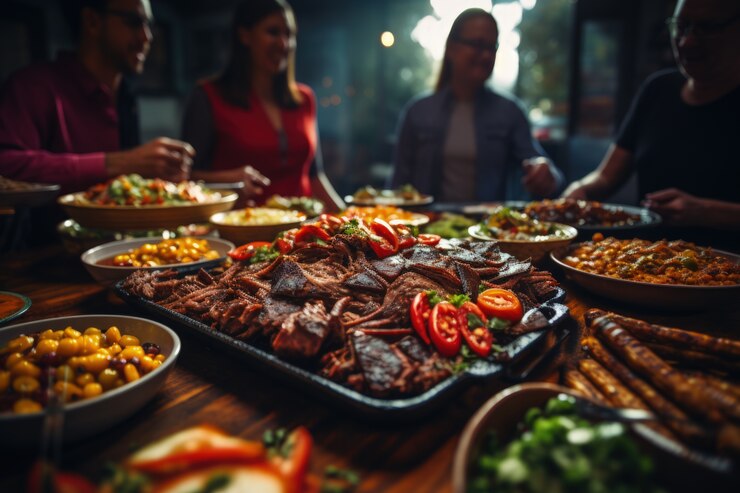Mamgatoto: A Taste of Africa in the Heart of American Dining

Mamgatoto is more than just a culinary concept; it is a vibrant bridge linking the rich, traditional cuisines of Africa with the diverse, expansive palate of American dining.
This unique culinary blend not only tantalizes taste buds with its rich flavors and robust textures but also serves as a symbol of cultural exchange and mutual appreciation. As we delve into the essence of Mamgatoto, we embark on a journey through its origins, its evolution into a culinary phenomenon, and its role in shaping the contemporary dining landscape in America.
This article aims to explore every facet of Mamgatoto, highlighting its significance as a cultural ambassador and a testament to the growing demand for culinary diversity.
The Origins of Mamgatoto
Mamgatoto’s story begins in the heart of Africa, where cooking is not merely a routine but a festive celebration of community and heritage. African cuisine is characterized by its use of rich spices, grains, and meats, all of which play a role in the creation of Mamgatoto. The name itself, derived from African dialects, symbolizes “motherhood” and “unity,” reflecting the dish’s role in communal gatherings and family meals. The historical context of Mamgatoto is rooted in these gatherings, where meals are a medium for passing down traditions and fostering community bonds.
In African culture, every meal is an opportunity to connect with others and share the richness of one’s heritage. Mamgatoto, with its complex flavors and communal serving style, encapsulates this ethos perfectly. It is not just the ingredients that make Mamgatoto special; it is the love and cultural pride infused in its preparation. This dish serves as a culinary canvas, showcasing the variety and depth of African agricultural and culinary traditions, from the use of native vegetables to the incorporation of spices like coriander, cumin, and cardamom that have been traded across the continent for centuries.
What is Mamgatoto?
Mamgatoto is a rich stew, often comprised of a base of tomatoes and onions, simmered with a variety of meats or fish, and enriched with a selection of herbs and spices that are quintessential to African cuisine. This base serves as the foundation for a myriad of variations that can include anything from root vegetables like yams and potatoes to leafy greens such as spinach and collards. The dish is renowned for its versatility and adaptability, reflecting the local ingredients and personal tastes of the cook.
Traditionally, Mamgatoto is served in a large communal pot, emphasizing its role in community and family settings. It is typically accompanied by side dishes that complement its flavors, such as rice, flatbreads, or plantains. The presentation of Mamgatoto is a crucial element of its enjoyment, with its vibrant colors and aromatic scents playing a pivotal role in the dining experience. This method of serving not only enhances the sensory enjoyment of the meal but also promotes a shared dining experience that is central to its cultural significance.
Cultural Fusion in Mamgatoto
The transition of Mamgatoto into the American culinary scene represents a fusion of traditional African cooking techniques with American influences. This integration involves a blend of African spice-infused cooking methods with American preferences for presentation and dietary variations. Chefs specializing in this cuisine might incorporate local American ingredients such as corn or squash, adapting the traditional recipes to appeal to a broader audience while preserving the essence of the original flavors.
In contemporary American restaurants, Mamgatoto is often presented with a modern twist—think deconstructed plates or fusion dishes that incorporate elements of both African and American cuisines. This modern interpretation not only makes Mamgatoto more accessible to those unfamiliar with African cuisine but also serves as a creative expression of culinary artistry, combining old and new-world flavors in innovative ways.
The Significance of Mamgatoto
Mamgatoto stands as a profound symbol of cultural exchange. It represents the growing appreciation and integration of African culture within the diverse tapestry of American society. Through Mamgatoto, diners are invited to explore and celebrate the richness of African culinary traditions, fostering a deeper understanding and appreciation for this rich cultural heritage. This dish does more than feed the body; it educates and unites people across cultural boundaries.
As America’s culinary landscape becomes increasingly diverse, dishes like Mamgatoto play a crucial role in broadening the palate of the American dining public. They introduce diners to new flavors and ingredients, expanding culinary horizons and promoting inclusivity in the culinary world. The popularity of Mamgatoto reflects a broader trend towards embracing global cuisines, driven by curiosity, respect for diversity, and a love of good food.
Flavors of Mamgatoto
Mamgatoto offers a complex flavor profile that is both bold and inviting. The spices used in its preparation—such as turmeric, ginger, and allspice—create a warm, deep flavor base that is both exotic and comforting. The use of fresh herbs adds brightness and contrast, elevating the rich flavors of the meats and vegetables. Each ingredient in Mamgatoto is selected to contribute to a harmonious whole, resulting in a dish that is rich in flavors and textures.
Eating Mamgatoto is a sensory journey that begins with the enticing aroma that fills the air during its cooking. This aroma sets the stage for the visual feast to follow, with its vibrant colors and hearty presentation. When tasting Mamgatoto, the complexity of flavors unfolds gradually, with the initial savory notes complemented by subtle hints of sweetness and spice. The variety of textures—from the tenderness of the meat to the creaminess of the vegetables—makes each bite a delightful experience, inviting diners to explore further.
Signature Ingredients & Culinary Techniques
The signature ingredients of Mamgatoto include native African vegetables and grains, as well as meats or fish that are often marinated and slow-cooked to perfection. Common ingredients such as cassava, millet, and sorghum reflect the agricultural traditions of various African regions. The incorporation of these ingredients not only enhances the authenticity of the dish but also contributes to its nutritional value, offering a range of vitamins, minerals, and antioxidants.
Mamgatoto is traditionally prepared through slow-cooking methods that allow the flavors to meld and intensify over time. This slow-cooking process is crucial for achieving the depth of flavor that Mamgatoto is known for. Modern interpretations of the dish often incorporate techniques such as braising or stewing in a Dutch oven or slow cooker, adapting the traditional methods to contemporary kitchen technology. This blend of old and new techniques ensures that Mamgatoto remains relevant and accessible to today’s cooks while retaining its cultural authenticity.
Nutritional and Health Benefits
Mamgatoto is not only delicious but also nutritionally rich. The variety of vegetables and spices used in its preparation provide essential nutrients that are vital for health. For instance, the leafy greens commonly used in Mamgatoto are excellent sources of vitamins A, C, and K, as well as iron and calcium. The spices, too, carry health benefits; for example, turmeric is known for its anti-inflammatory properties, while ginger supports digestive health.
The health benefits of Mamgatoto extend beyond its nutritional content. The dish’s rich array of spices and ingredients can help boost the immune system, reduce inflammation, and support overall health. Additionally, the versatility of Mamgatoto makes it easy to adapt to various dietary needs, including vegetarian, vegan, and gluten-free options. This adaptability not only makes Mamgatoto a healthy choice but also an inclusive one, suitable for diverse dietary preferences and restrictions.
How to Experience Mamgatoto
For those looking to experience Mamgatoto, many African restaurants across the United States offer this dish, each with its regional twist. Dining at these establishments not only supports local businesses but also provides an authentic experience of African culinary traditions. Many chefs are proud to share their heritage through their cooking, often providing insights into the history and significance of the dishes they serve.
Alternatively, preparing Mamgatoto at home can be a rewarding endeavor. Many recipes and cooking guides are available online, offering step-by-step instructions for creating this dish. Cooking Mamgatoto at home allows for personal customization of ingredients and spices, making the dish a personal journey of culinary discovery. It also presents an opportunity to involve family and friends in the cooking process, making the meal a communal and educational experience.
Community & Cultural Impact
Mamgatoto’s role in community building cannot be overstated. In both Africa and America, the dish has catalyzed the gathering of people together, fostering a sense of community and shared heritage. In the American context, Mamgatoto provides a means for African immigrants and their descendants to connect with their roots and share their culture with others. It also opens up dialogues about cultural diversity and inclusivity, making it a powerful tool for cultural exchange.
The widespread interest in Mamgatoto has also spurred educational opportunities. Cooking classes, cultural festivals, and culinary tours that focus on African cuisine offer ways for people to learn more about the history, ingredients, and preparation of Mamgatoto. These educational initiatives not only promote cultural appreciation but also enhance the public’s understanding of the richness of African culinary traditions.
Conclusion
Mamgatoto is more than just a dish; it’s a vibrant testament to the power of culinary fusion and cultural exchange. This culinary ambassador bridges the gap between African heritage and American dining, offering a palette of flavors that educates, delights, and unites. Through Mamgatoto, diners not only savor the rich tapestry of flavors but also partake in a broader cultural dialogue that celebrates diversity and fosters understanding.
As the demand for diverse dining experiences continues to grow, Mamgatoto stands poised to enrich palates and hearts with its rich heritage and flavorful offerings. Whether experienced in the convivial atmosphere of a restaurant or the intimacy of a home kitchen, Mamgatoto offers a journey of discovery—one that speaks to the universal language of food and community.
FAQs
What is Mamgatoto? Mamgatoto is a culinary concept that blends African culinary traditions with American dining practices, symbolizing cultural exchange and diversity.
How does Mamgatoto contribute to cultural exchange? It serves as a bridge between African heritage and American cuisine, fostering understanding and appreciation for African traditions through food.
Can Mamgatoto be adapted for different diets? Yes, Mamgatoto recipes can be customized to accommodate vegetarian, vegan, gluten-free, and other dietary preferences.
Where can I try Mamgatoto? Mamgatoto is available at select African restaurants or can be made at home using traditional recipes and ingredients.
What are the health benefits of Mamgatoto? It includes nutritious ingredients like spices known for their anti-inflammatory properties and a variety of vegetables rich in vitamins and minerals.
You may like to read about the following:
SSIS 816: A Comprehensive Guide to Microsoft’s Data Integration Tool
Connor Bird: The Untold Story of Larry Bird’s Son
Della Beatrice Howard Robinson: All About Ray Charles’ Ex-Wife
Roberta Franco: Biography, Age, Net Worth, Career, Everything to Know
Dinah Mattingly: Biography, Age, Net Worth, Career, Everything to Know
For more information, Visit Celebrity World



